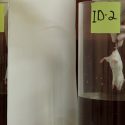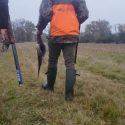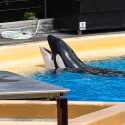While Australia and England persist in using forced swimming tests, One Voice continues its fight in France.
Archives: News
A wolf hit by a train in Drôme
Another wolf the victim of a collision… One Voice condemns this silent massacre.
Hunting: a weapon of mass pollution
Hunting: a weapon of mass pollution
Hunting: a weapon of mass pollution
07.07.2023
Hunting: a weapon of mass pollution
Hunting
A few months ago, the Fédération nationale des chasseurs (FNC) [National Federation of Hunters] was condemned for having presented its members as the “first ecologists in France” (which the French have never believed!). And we understand why: this hobby leads not only to the death of more than 25 million animals every year, but, the cherry on the cake, it pollutes the earth by depositing 6000 to 8000 tonnes of lead. This ammunition left in nature is an instant danger to the environment, animals, and humans, the dramatic consequences of which are already being seen. In Ain, One Voice found out from the Prefecture that lead shots replaced with steel ammunition in a clay-pigeon shoot had been organised in a wetland last weekend. But with checks being rare, we have no illusions about the changed course of this, knowing that this annual polluting festivity has taken place for more than twenty years on the same land.
From hunting to clay-pigeon shooting: a short guide on polluting activities by hunters in France
Sometimes – or dare we say often? -, hunters miss their targets. Thousands of lead bullets are therefore spread throughout the earth and water courses, making them potentially infertile and toxic, in particular for us humans. When animals feed on them, they are almost certain to die: a duck that ingests four small balls of this dense metal has a 99% chance of dying in the next twenty days. Other times, animals are affected without being killed. They have to live with shots throughout their bodies causing illnesses and infections – a body which will then be ingested by their natural predators, such as lynx, which are protected. One animal at a time, this heavy metal, a true poison, gains ground.
And it does not stop there: outside of the season, they have to be careful! There is still one activity left: clay-pigeon shooting. Shooting at a clay disk is undoubtedly less amusing than shooting at an animal. But it is “better than nothing”. This very lucrative activity in itself leads to 1,500 tonnes of lead being dispersed in nature every year.
An event in Ain that has been harmful for the environment for two decades
In Ain, the Douvres Hunting Society has been organising an annual clay-pigeon shoot in close proximity to a water course for at least twenty years. In other words, for all these years, the earth and groundwater tables have been riddled with this heavy metal… Also in this region in 2014, it was revealed in the autopsy of a lynx cadaver that it was suffering from lead poisoning because its body had more than 120 bullets in it. Having been alerted to the event taking place on the weekend of 1 July, we immediately contacted the Prefecture, who told us they got hunters to only use steel ammunition. Hard to believe, when we know that the guns used for clay-pigeon shooting are not adapted for this type of cartridge.
Beyond the pollution, this event should never have taken place. In fact, the Ain Prefect herself banned the carrying and transportation of weapons in the Department between 30 June and 3 July due to national current events. Despite this, these Sunday shooters have been able to indulge in their hobby without any disturbance!
Who knows, perhaps hunters were able to convince her that it was absolutely essential to “regulate” the clay discs…
General rallying against the ravages of hunting on nature
Of course, since February 2023, the use of cartridges is banned in close proximity to wetlands. But this measure is largely insufficient. With the European Environment Bureau, a coalition that One Voice is a member of, we are asking the European Commission to go further with the restrictions on lead in ammunition and fishing accessories. Because fish are also as important as mammals. The very survival of millions of animals and protecting human health is at stake!
As usual, hunters will do everything they can not to have to follow the rules. In January 2023, environmental police officers had apparently received no instructions on implementing checks[1]. The law? A tiny detail when it comes to pleasing a small minority who want to kill yet more animals. And they don’t stop there! Willy Schraen (FNC President) went so far as to ask for financial support from the State so that his members could replace their guns at taxpayers’ expense. The indecency clearly has no limit.
While the effects of massive soil pollution are already being felt by biodiversity and human health, it is about time we act. More than ever, it is about supporting the interests of animals, humans, and nature with one voice. Standing bravely with our partners, we will continue working to protect life on earth, for which whistle-blowers and conservationists are too often targeted. For them, for us, nothing will stop us. On 12 July at the European Parliament, we will call on Members of the European Parliament to pass the European Law on the restoration of nature.
[1] Source: chassons.com site, “Plomb interdit à la chasse: Vers un possible report?” [Lead banned in hunting: for a possible adjournment?] article of 4 January 2023: “Indeed, for the time being, no agent from the French Office for Biodiversity (OFB) has received clear instructions on the implementation of checks on the use of ammunition for which they will be responsible.”
Translated from the French by Joely Justice
One Voice is calling for the European law to restore nature to be passed
At the centre of political tensions, the Law on the Restoration of Nature must be voted on by the European Parliament on 12 July.
The Wolf Plan: a planned failure
The wolf population is in decline in France: One Voice condemns this predictable massacre.
Official opening of the Chatipi to help stray cats in Marly-le-Roi on 8 July at 11am
One Voice, who has fought against feline straying for years, is implementing three-way partnerships with town councils or drop-in centres and local associations to microchip, neuter, and care for homeless cats and release them, while providing them with a wooden chalet for them to rehydrate themselves, eat, and take shelter.
The Marly-le-Roi Town Council in Yvelines contacted the One Voice Association to take care of the problem of stray cats in the town with the help of the local MarlyChats sans Toit Association. The Chatipi programme therefore means that cats without a human family will no longer suffer from deprivation. The opening will take place at the Chatipi on Saturday 8 July at 11pm.
In Tenerife, Loro Parque will stop at nothing to make a profit from Morgan
In Tenerife, Loro Parque will stop at nothing to make a profit from Morgan
In Tenerife, Loro Parque will stop at nothing to make a profit from Morgan
27.06.2023
In Tenerife, Loro Parque will stop at nothing to make a profit from Morgan
Exploitation for shows
Last May, along with Ingrid Visser, a biologist specialising in orcas, we went to see Morgan and her captive companions Keto, Tekoa, and Adan in Tenerife. In the Loro Parque pools, she was exploited relentlessly to attract yet more visitors. We have been fighting for almost fifteen years for her to be transferred to a marine sanctuary.
Morgan was captured off the coast of the Netherlands in 2010, alone and emaciated, when she was just a youngster. Yet while the programme authorising her to be seized laid out the conditions for her to get back into shape then to be freed into the North Sea, where her family were waiting for her, this never happened. Instead, she was sent to the tropical latitudes of Spanish dolphinarium Loro Parque, off the coast of Africa, to boost the captivity industry.
A few years after her arrival in the Canaries, Morgan gave birth to her first baby. “An accident” according the park, who failed to prevent the death of her baby Ula less than three years later. Today, Loro Parque does not see any problem with keeping the 16-year-old orca and Keto, Ula’s father, in the same pool… They are no doubt looking for her to get pregnant again, thus making it possible for them to profit a bit more off the back of a new captive.
An orca used as a lucrative attraction
Morgan is put at the centre of the show for the public. She has to do a series of leaps out of the water, splashing the seating area so that she can… eat. On the big screen, the dolphinarium tells the moving story, while completely changing it, of her ‘rescue’. To justify her being kept captive and continuing to profit off the back of her, they do not mind telling lies.
Telling anyone about the aggression between orcas and towards the trainers is carefully avoided. However, Tekoa’s father is Tilikum, the infamous hero from the Blackfish documentary that allowed many people to open their eyes to the reality of these detention centres.
Loro Parque has gone so far as to present the image of a happy family of orcas, instead of a group of individuals unbalanced by boredom and, in particular, a lack of space. Keto’s violent matings on the only female of the group are romanticised, and the awful confrontations between Adan and Tekoa, whose body in covered in bite marks, are left unspoken. However, as well as little Ula being born with a fin deformity, two other orcas have died in the last two years: Skyla and Kohana.
Morgan, who is suffering from dental issues and behavioural problems, is now the only orca born in the wild to be kept in a European park. Her exploitation must stop!
Alongside the New-Zealander marine biologist Ingrid Visser and the Free Morgan Foundation, we have been fighting since the start for her to be freed from the concrete pool where she is imprisoned. Together, we are asking that she be transferred to a sanctuary where she can finally live with free will, far from the violence of the shows forced upon her. And perhaps find her family again, located along the Norwegian coast.
Translated from the French by Joely Justice
Instructions for public consultation on species likely to cause damage: how to oppose the ministerial draft decree in concrete terms
Instructions for public consultation on species likely to cause damage: how to oppose the ministerial draft decree in concrete terms
Instructions for public consultation on species likely to cause damage: how to oppose the ministerial draft decree in concrete terms
22.06.2023
Instructions for public consultation on species likely to cause damage: how to oppose the ministerial draft decree in concrete terms
Wildlife
From 15 June to 6 July, citizens are invited to give their opinion on the ministerial draft decree that will set which animals are considered as ‘species likely to cause damage’ and are victims of merciless hunting year-long for the next three years. A cruel list with no foundation – since the so-called damage is declarative and either little or badly verified – which we are helping you to oppose along with us.
Updated every three years, the law setting the periods for and ways of killing animals classified as species likely to cause damage must in principle respond to specific requirements. It should also, whether protecting public health and safety or flora and fauna, prevent significant damage to agricultural, forestry, and aquacultural activities or any other kind of property. These claims, which we have particularly seen when coming to the aid of crows and ravens in Jura, are rarely implemented precisely by prefectures, which seem much quicker to please hunters than to be demanding on the reality of the problems that they put forward… Fortunately, there are many arguments to defend these blindly condemned animals against these destructive desires.
In the public consultation, you will find the draft decree, which specifies the animals targeted in each department in the appendix. Just below the link to download this decree, you can “leave a comment”. You can decide, for example, only to express yourself regarding animals in the department you live in, which will give weight to your participation.
Below we have given you some information to express your opposition to this classification. Of course, we believe that all animals have an intrinsic value that must not be compared with any human interests. But we are obliged to adapt our argument to the situation, at the risk of not being heard. Note: any copy and pasting will not be taken into account and it is therefore essential that you reformulate the arguments that you choose into your own words.
Animals are necessary for biodiversity
Not only do the individuals that the authorities want to hunt down have intrinsic value, but they are also intelligent and capable of experiencing suffering, as well as being essential to the environment, which the draft decree absolutely does not take into account, choosing to forget about their positive impact which is not insignificant.
By contributing to the regulation of the number of small rodents, foxes do us a lot more of a service than you may think. Simply by being present, they limit the movement of mice and other small rodents, which, by remaining at the entrance to their burrows, are less of a risk of transmitting Lyme disease to humans. But foxes are also beneficial to crops. By reducing the number of voles, they contain the damage caused in fields and thus the use of pesticides, which are harmful to ecosystems.
Rooks, carrion crows, Eurasian jays, and Eurasian magpies promote the dispersal of the grains that they eat and maintain the wild flora. Eurasian jays and Eurasian magpies even play a central role in forest renewal by supporting the development of oak and pine trees, while rooks and carrion crows protect crops from certain destructive insects whose larvae they eat.
Unnecessary or even counter productive measures
Many scientists agree in saying that mass slaughtering, which we will never accept no matter what the reason may be, does nothing to protect human interests.
We know that killing foxes to try to protect against diseases that are transmissible to humans and breeding animals to be sent to the abattoir is completely delusional. We can cite the Luxembourg case, which took foxes off the list of huntable species in 2015 and saw the number of cases of alveolar echinococcosis go from 40% down to 25% according to biologist Frédéric Jiguet. Weasels, martens, and stone martens have no chance of transmitting diseases to humans.
Birds classified as species likely to cause damage, in particular rooks, carrion crows, and starlings, are very intelligent and capable of implementing reproduction or emigration strategies to compensate for the loss of individuals that succumb. Suffice to say that the only ones to benefit from their death are those who take pleasure in slaughtering them with guns…
Along with us, ask for these animals to be taken off the list of species likely to cause damage and for the implementation of true alternative solutions to protect agricultural and other types of exploitation. If you are unable to post your comment on the Ministry’s site, as many people have reported to us, almost certainly due to the page being overcrowded, we recommend that you register to post it later. We are counting on you!
Participate in the public consultation
In concrete terms
GENERALLY:
- animals are sensitive and sentient beings;
- the positive impact of these animals, just as good for ecosystems as they are for human activity, is absolutely not taken into consideration by the draft decree submitted for consultation;
- it is not shown that the regulation of these species’ populations has a positive impact on protected interests by classifying them as species likely to cause damage: on the contrary, the assessment is negative or even counter productive;
- damage can be avoided by implementing true alternative solutions, such as filling in open holes in fences and coops, or combining several scaring methods in fields;
- compilations of damage rely on a uniquely declarative biased model (declarations come from farmers and are often collected by hunters or trappers) which is not subject to any checks by the State.
THE POSITIVE IMPACT OF THESE SPECIES:
Foxes and small carnivorous mammals:
- weasels, martens and stone martens: they contribute to the regulation of the number of small rodents that destroy crops – voles in particular – and must be considered as allies rather than enemies;
- They curb the spread of Lyme disease: when there are predators, small rodents, who are vectors for the transmission of the disease, move less and stay closer to their burrows, thus lowering the risk of transmitting the disease.
- weasels, martens and stone martens and public safety/health: weasels, martens, and stone martens do not pose a risk for human health given that these species are unlikely to transmit diseases/bacteria that they harbour to human beings.
- foxes and public safety/health: specialists of this species who are interested in the issue of zoonotic diseases agree that slaughtering foxes due to the diseases that they could transmit to humans and to farm animals is scientifically unjustified. As shown by the Luxembourg case, following foxes being taken off the list of huntable species in 2015, it saw the number of cases of echinococcosis contaminations go from 40% down to 25% according to biologist Frédéric Jiguet.
Finally, particular emphasis should be placed on foxes’ role in regulating small rodents due to the majority (almost exclusively in some cases) of their diet being made up of voles whose ‘proliferations’ are often seen. Sparing the lives of foxes also avoids having to battle with chemicals to combat voles in fields.
Birds: 4 corvids and common starlings:
The regulation of birds classified as species likely to cause damage is portrayed by many scientists as unnecessary or even counter productive. It is currently accepted that some species (in particular rooks, carrion crows, starlings) compensate for the losses in their populations linked to regulation with reproduction or emigration strategies.
- corvids: rooks, carrion crows, Eurasian jays, and Eurasian magpies: corvids’ diets are mainly composed of grains. Thus, they play a fundamental role in grain dispersion of wild flora.
- rooks and carrion crows: they play the role of ‘cleaner’ for dead animals (or those too weak or sick to survive in the wild) and also have a beneficial role for insects that destroy crops as they eat their larvae.
- Eurasian jays and Eurasian magpies: these two species play a key role in the natural renewal of forests, since they have an impact on the dissemination and development of oak and pine trees.
Participate in the public consultation
Translated from the French by Joely Justice
The courts have recognised that ravens and crows in Jura were illegally massacred in summer 2022
The courts have recognised that ravens and crows in Jura were illegally massacred in summer 2022
The courts have recognised that ravens and crows in Jura were illegally massacred in summer 2022
21.06.2023
The courts have recognised that ravens and crows in Jura were illegally massacred in summer 2022
Wildlife
On 13 June, the Besançon Administrative Tribunal ruled in One Voice’s favour by cancelling the prefectural decree of 24 March 2022 allowing the trapping and killing of carrion crows and rooks in Jura up to 31 July. The birds massacred during this time were done so illegally. Strengthened by this decision going in our favour, we will continue to fight for them as for all animals classified as species likely to cause damage.
In March 2022, when the Jura Prefecture once again authorised the unlimited trapping and killing of carrion crows and rooks living in their area in accordance with them being classified as a species likely to cause damage, we attacked this decision immediately. Our request for an urgent suspension was refused, condemning these birds to be killed relentlessly for an additional four months. As though the famine due to the spreading of pesticidesor growing urbanisation does not already affect them enough, the sixth mass extinction of animals currently happening hits birds particularly hard…
A conveniently forgotten public consultation
This law was in fact illegal, and not only a little. By cancelling our request of 13 June, the Besançon Administrative Tribunal recognised that the Prefect’s decree had not undergone public consultation before being passed. A serious error: citizens must be consulted for any decision that has an impact on the environment. And who would believe that the massacre of carrion crows and rooks, who play a fundamental role for biodiversity, has no impact on the environment?
Action against the list of species likely to cause damage by the Ministry
This persecution against animals that are victims of being classified as species likely to cause damage must stop. For crows and ravens, but also for foxes, martens, jays, and many others, we have been preparing to counter the new ministerial decree that will sentence them to death from the end of the summer for months. From 15 June, this bill is open to public opinion. There have been so many people wishing to participate in the consultation that the Ministry’s website has been full since its launch! Our rallying started months ago with the request to each prefecture for statements of the presumed damage. We found some gems: foxes attacking cows in a group, requests for the cost of eggs valued at the price of gold…
We are preparing our plea to the State Council to challenge this ministerial list of animals still wrongly considered as pests despite their change in name thanks to the associations’ insistence, and given that, in the wild, good and evil do not exist…
Refuse this absurd classification of sensitive and intelligent beings along with us by participating in the public consultation until 6 July. To help you to defend animals, you can refer to our substantive article on the subject.
Translated from the French by Joely Justice
ba&sh’s animal welfare policy recognised by the Fur Free Retailer programme
The ba&sh brand has today been rewarded for banning fur by joining the Fur Free Retailer programme.









